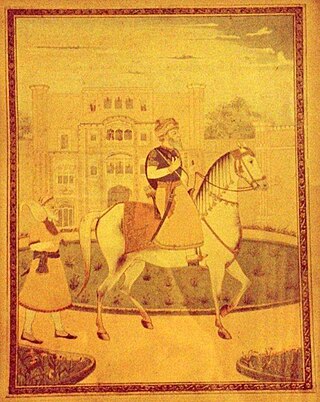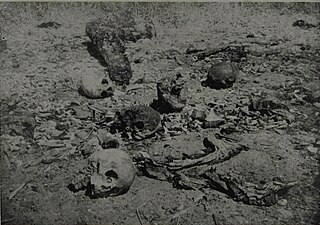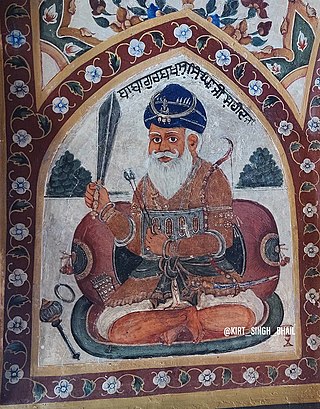
The Sukerchakia Misl was one of twelve Sikh misls in Punjab during the 18th century, concentrated in Gujranwala and Hafizabad districts in western Punjab and ruled from (1752–1801). The misl was founded by Charat Singh of Sandhawalia, grandfather of Maharaja Ranjit Singh. The last Sukerchakia Misldar was Maharaja Ranjit Singh. Towards the end of the eighteenth century, Maharaja Ranjit Singh united all the misls and established an independent Sikh Empire.

Maha Singh, also spelt as Mahan or Mahn Singh, was the second chief of the Sukerchakia Misl. He was the eldest son of Sardar Charat Singh and Sardarni Desan Kaur Warraich. He was the father of Sher-e-Punjab Maharaja Ranjit Singh.
Dal Khalsa was the name of the combined military forces of 11 Sikh misls that operated in the 18th century (1748–1799) in the Punjab region. It was established by Nawab Kapur Singh in late 1740s.
Guru Nanak founded the Sikh religion in the Punjab region of the northern part of the Indian subcontinent in the 15th century and opposed many traditional practices like fasting, janeu, idolatry, caste system, ascetism, azan, economic materialism, and gender discrimination.

Jassa Singh Ramgarhia (1723–1803) was a prominent Sikh leader during the period of the Sikh Confederacy. He was the founder of the Ramgarhia Misl.

Sultan-ul-Qaum Sardar Jassa Singh Ahluwalia was a Sikh leader during the period of the Sikh Confederacy, being the Supreme Leader of the Dal Khalsa. He was also Misldar of the Ahluwalia Misl. This period was an interlude, lasting roughly from the time of the death of Banda Bahadur in 1716 to the founding of the Sikh Empire in 1801. He founded the Kapurthala State in 1772.
Sardar Hari Singh Dhillon was an 18th century Sikh warrior and the chief of Bhangi Misl. During the formation of the Dal Khalsa he was acknowledged as leader of Tarna Dal, and he was made chief of Bhangi Misl following the death of Bhuma Singh Dhillion, who he was the adopted son of, in 1748. Hari Singh made the Bhangi Misl the most powerful of all the Misls. He was described as brave and fearless as well as a great warrior. Under Hari Singh the Bhang Misl expanded to Jammu, Lahore, Chiniot, Buria, Jagadhari, Firozpur, Kushab, Majha, Malwa, Sandal Bar and Jhang.

Baghel Singh was a Military general in the Punjab region in the northern part of the Indian subcontinent in the 18th century. He rose to prominence in the area around Sutlej and Yamuna. He joined the Singh Krora Misl, one of the misls during Sikh Confederacy. In 1765, Singh became the leader of the misl.

Ramgarhia Bunga or Burj is the three-storeyed red stone watchtowers complex located near southeastern edge of the Golden Temple, Amritsar. The two minaret-style Ramgarhia Bunga high towers are visible from the parikrama (circumambulation) walkway around the Harmandir Sahib Sarovar. It is a pre-Ranjit Singh structure built by Sikh warrior and Ramgarhia misl chief Jassa Singh Ramgarhia in late 18th-century, after the 1762 destruction and desecration of the Sikh holy temple and site by the Afghan Muslim forces led by Ahmed Shah Abdali. The Bunga watchtowers-related infrastructure was constructed to station sentinels to watch for any surprise attack, house soldiers to help fortify the area, and to protect the holy complex from desecration.

Vadda Ghalughara was the mass murder of unarmed Sikhs by the Afghan forces of the Durrani Empire during the years of Afghan influence in the Punjab region of the Indian subcontinent owing to the repeated incursions of Ahmad Shah Durrani in February 1762. It is distinguished from the Chhota Ghalughara. Mostly non-combatants were killed in the event, and an estimated that 10,000 to 50,000 Sikhs were killed on 5 February 1762.

Sardar Charat Singh, also romanised as Charhat Singh, was the founder of Sukerchakia Misl and father of Mahan Singh, and the grandfather of Ranjit Singh. He distinguished himself at an early age in campaigns against Ahmad Shah Abdali and along with 150 horsemen split from the Singhpuria Misl to establish the Sukerchakia Misl.

The Afghan–Sikh wars spanned from 1748 to 1837 in the Indian subcontinent, and saw multiple phases of fighting between the Durrani Empire and the Sikh Empire, mainly in and around Punjab region. The conflict's origins stemmed from the days of the Dal Khalsa, and continued after the Emirate of Kabul succeeded the Durrani Empire.
The Battle of Kup was fought on 5 February 1762, between the Afghan forces of Ahmad Shah Durrani and the Sikhs, under the command of Jassa Singh Ahluwalia and Charat Singh. Ahmad Shah Durrani and the Afghan forces reached Malerkotla, west of Sirhind. They were met by between 30,000 and 50,000 Sikhs. Abdali's forces outnumbered the Sikhs in hand-to-hand combat and the Sikhs couldn't use their usual tactics of hit and run, but had to engage in battle while protecting the civilians at the same time. The Sikhs created a human ring around civilians as protection and fought the battle as they advanced towards Barnala. Abdali was able to break the ring and carried out a full scale massacre of the Sikh civilians. Ahmad Shah's forces killed several thousand Sikhs, and the surviving Sikhs fled to Barnala. According to various different estimates, as many as 5,000 to 30,000 Sikh men, women, elderly and children were killed in what is known as the second Sikh genocide.

Ahmad Shah Durrani, the founder of the Durrani Empire, invaded Indian subcontinent for eight times between 1748 and 1767, following the collapse of Mughal Empire in the mid-18th century. His objectives were met through the raids and deepened the political crisis in India.
The Battle of Manupur was fought between the Mughal Empire and the Durrani Empire in March 1748 near Sirhind which ended in victory for the Indian coalition.

Ramgarhia Misl was a sovereign state (misl) in the Sikh Confederacy of Punjab region in present-day India and Pakistan. The misl's name is derived from Qila Ramgarh, a place located in Ramsar, near Amritsar, which was fortified and redesigned by Ramgarhia Misl chief Jassa Singh Ramgarhia. The Ramgarhia Misl was one of the twelve major Sikh misls, and held land near Amritsar.

The Battle of Delhi was fought between Khalsa Sikhs and the Mughal Empire in 1783.

Baba Gurbaksh Singh was a Sikh warrior from the 18th century who served under the Shaheedan Misl of the Sikh confederacy. Gurbaksh Singh along with 29 other Sikh warriors led a last stand against the Afghan and Baloch forces on December 1, 1764, at Amritsar. It was in this skirmish that Baba Gurbaksh Singh along with 29 other Sikhs were killed.
The Battle of Darbar Sahib was fought in 1764, during the Afghan-Sikh Wars, between the Shaheedan Misl of the Sikhs and the Durrani Empire of Ahmad Shah Abdali aided by the Khanate of Kalat.
The Battle of Qarawal was fought between the Sikhs under the command of Charat Singh against the Afghan forces led by Ahmad Shah Abdali and his Kalat ally Mir Nasir Khan I.The battle resulted in a victory for the Afghan forces and forced the Sikhs to withdraw to Amritsar.











